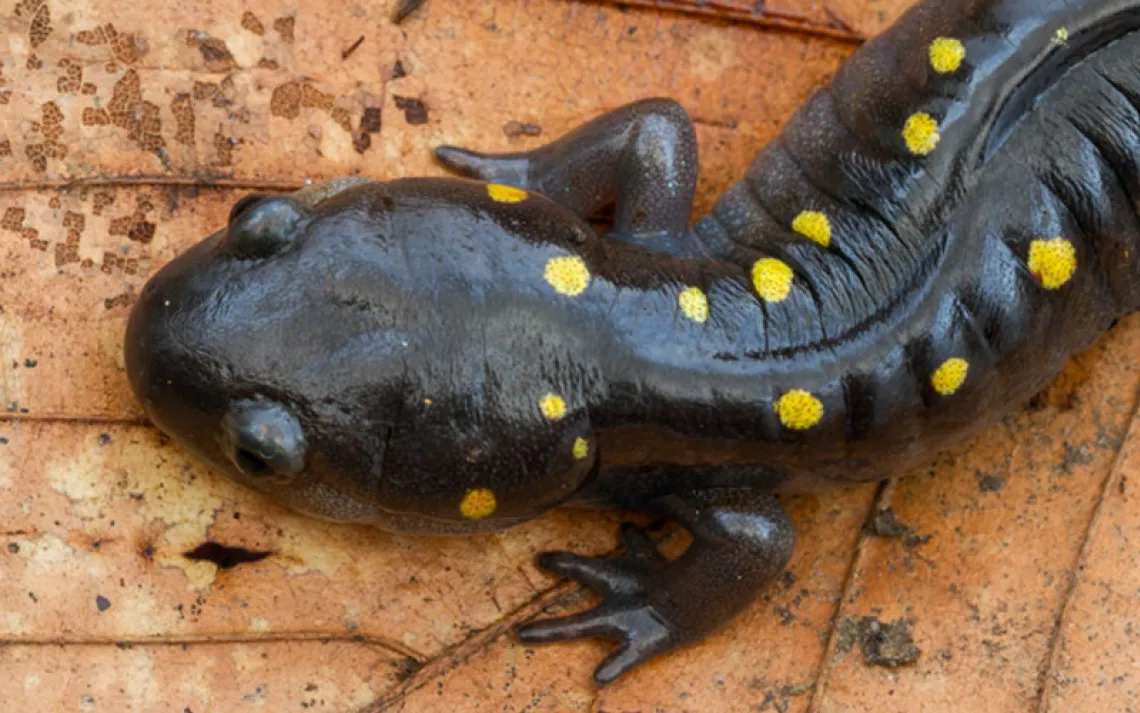Zoos Gone Wild—With Hope
How some are giving animals a leg up in the face of climate change

Wood frog | Courtesy of Cleveland Metroparks
For the past few decades, members of the Association of Zoos and Aquariums throughout the United States have been partnering up with private organizations and local, state, and federal agencies to restore and reintroduce species into their natural habitats.
They’ve also been stepping in to preserve land in their own backyards (as well as further afield)—to give mammals, reptiles, insects, and fish a leg up as climate change, development, pollution, and other threats continue to challenge their survival.
Below are a few highlights among the many innovative programs that are currently operational at zoos and aquariums around the country.
Cleveland Metroparks: Local Wetlands Conservation and Creation
In 2005, Cleveland Metroparks conducted a survey of the wetlands that exist within its 24,000 green acres ringing the city. The survey concluded that these wetlands were in generally good—if variable—shape, says director of natural resources Terry Robinson. And it identified ways to maintain and restore quality: increasing buffers on waterways that enter the park; eliminating runoff from local municipalities; and retrofitting parking lots with bioswales to remove salt and sediment—all of which help keep delicate wetlands contaminant-free.
Metroparks also began creating new wetlands and rehabilitating others, starting with seeding in native grasses and replacing essential shade-producing trees destroyed in previous years by the emerald ash borer. As a result, says Robinson, “We had immediate occupancy on one site by wood frogs, which need clean water and good conditions, and colonization by green frogs pretty quickly on another.”
Courtesy of Cleveland Metroparks
Woodland Park Zoo: Silverspot Butterfly & Western Pond Turtle
Efforts to revive the federally threatened Oregon silverspot butterfly have seen the Woodland Park Zoo in Seattle (along with the Oregon Zoo) raising larvae in a predator-free lab for the past 18 years. Rounding out the partnership for this project are the US Forest Service, the Nature Conservancy, and the US Fish and Wildlife Service, whose recovery and habitat-management teams maintain local populations of the blue violets that silverspots use as larval host plants and pull weeds and study soil concentrations. “I can make butterflies till the end of days, but without a healthy place to put them, [reintroducing butterflies] isn’t going to succeed,” says Erin Sullivan, who runs Woodland Park’s breeding program. Several thousand pupae have been released since 2001, and five populations established.
Woodland Park’s head-start program for Washington-listed endangered western pond turtles, also run in collaboration with the Oregon Zoo, has been operational since 1991. In that time, it’s collected turtle eggs every spring, raised them over winter in its lab, then released juveniles to six sites around Puget Sound and the Columbia River Gorge. There, the small, shelled reptiles have to battle invasive canary grass, which impedes their nesting-box-building, and non-native bullfrogs, which eat their hatchlings; the Washington Fish and Wildlife Service mows the grasses and removes adult frogs to give the turtles (which can live up to 70 years) a fighting chance. “Every adult female is important, and the loss of one can have a significant impact on this population,” says curator Jennifer Pramuk, who runs Woodland Park’s project. “We hope some day head-starting won’t be necessary, but in the meantime, we’ve made incredible inroads to keeping the species from going extinct in our state.”
Courtesy of Woodland Park Zoo | Photo by Jeremy Dwyer-Lindgren
Toledo Zoo: Urban Prairies
Toledo Zoo conservation manager Ryan Walsh has a mission, and that’s to swap out the zoo’s and the city’s abundant and resource-depleting turf grass with prairie grasses and other plants native to the region. Since the program began in 2014, the zoo has managed to secure 48 prairie sites for a total of 43 acres, including some in schools and otherwise abandoned lots, working with the city of Toledo, the Lucas County Land Bank, and other private and public partners.
What’s been gratifying to see is that, “within two years of [prairie] installation, butterfly diversity increases 26 times, reptile species by two to three times (which is pretty good, since we don’t have a lot of native reptiles), and bee species increase by about six times,” says Walsh. The federally endangered rusty-patched bumblebee was a confirmed inhabitant last year. Another, unplanned-for development: Local enthusiasm for planting natives has amped up to the point that the zoo’s nursery has begun selling a variety of plants on-site and at farmers' markets.
St. Louis Zoo: American Burying Beetle & Ozark Hellbender
For nine years, Bob Merz conducted field studies to find evidence that the American burying beetle still existed in one of 35 states east of the Rocky Mountains, where it was common until the mid-1970s. When those expeditions failed, the now-director of the Center for American Burying Beetle Conservation got to work on plans to reintroduce it. With help from founder beetles shipped in from Arkansas, the center has raised over 12,000 in 15 years and reintroduced them as young adults to four sites, where US Fish and Wildlife, according to Merz, “felt confident in saying that no beetles existed there; that means any beetles found can be assumed to have come from our beetles.” One of these sites is a pristine, diversely populated prairie in Missouri owned by the Nature Conservancy, where prairie chickens were successfully restored for several years. The beetles here, too, appear to be reproducing. Now, says Merz, “It’s time to pull away and see how they do on their own.”
Photo by Dylan Cebulske
The world’s first captive hellbender program began in St. Louis in 2004—even though giant hellbender scientists in Japan and China told zoological manager of herps and aquatics Mark Wanner that it was impossible. Since then, 6,111 of the largest salamanders in North America—of which one species is federally endangered and the other is listed in Ohio—have been released into local rivers and streams. “It took us four years to figure out how to do it, and what it came down to was water quality and the addition of artificial nest boxes,” which are built in-house, Wanner says. The zoo also works with landowners to mitigate sedimentation from development, to keep the hellbenders’ larval habitat as clean and clear as possible.
New York Aquarium: New York Seascape
About 16,000 square miles of northeastern ocean coastline—from Long Island, New York, to Cape May, New Jersey—exist within a busy, urbanized ecosystem that presents myriad challenges to the species that live there and migrate through it. The New York Aquarium will be teaming up with the New York Ocean and Great Lakes Coalition, among other partners, to create numerous protections for marine life—like American eel, river herring, blue sharks, and smooth dogfish. It’s an intricate, multifaceted, and long-term plan, which, if successful even by a few measures, will dramatically impact this region of the Atlantic for many decades to come.
Smithsonian’s National Zoo and Conservation Biology Institute: Grasslands & Bison
Can restoring extensive acreages of grassland in the American west give a boost to the few small herds of bison that still roam on protected lands? An ambitious three-year collaborative project between the Smithsonian—which will send conservation biologists to grassland sites to coordinate research efforts—and the American Prairie Reserve (APR), aims to find out. APR has already purchased 400,000 grassland acres in northeastern Montana, and it plans to link up a total of 3 million to create interconnected wild spaces that will allow bison—and also elk, pronghorn, and other species large and small—to repopulate, and hopefully, thrive.
Courtesy of Cleveland Metroparks
 The Magazine of The Sierra Club
The Magazine of The Sierra Club



